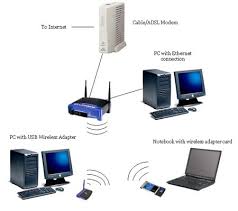
Wireless technologies
Terrestrial microwave –
Terrestrial microwaves use Earth-based transmitter and receiver. The equipment looks similar to satellite dishes. Terrestrial microwaves use low-gigahertz range, which limits all communications to line-of-sight. Path between relay stations spaced approx, 48 km (30 mi) apart. Microwave antennas are usually placed on top of buildings, towers, hills, and mountain peaks.
Communications satellites –
The satellites use microwave radio as their telecommunications medium which are not deflected by the Earth's atmosphere. The satellites are stationed in space, typically 35,400 km (22,000 mi) (for geosynchronous satellites) above the equator. These Earth-orbiting systems are capable of receiving and relaying voice, data, and TV signals.
Cellular and PCS systems –
Use several radio communications technologies. The systems are divided to different geographic areas. Each area has a low-power transmitter or radio relay antenna device to relay calls from one area to the next area.
Wireless LANs –
Wireless local area network use a high-frequency radio technology similar to digital cellular and a low-frequency radio technology. Wireless LANs use spread spectrum technology to enable communication between multiple devices in a limited area. An example of open-standards wireless radio-wave technology is IEEE 802.11.
Infrared communication-
Infrared communication can transmit signals between devices within small distances of typically no more than 10 meters. In most cases, line-of-sight propagation is used, which limits the physical positioning of communicating devices.
A global area network (GAN)-
is a network used for supporting mobile across an arbitrary number of wireless LANs, satellite coverage areas, etc. The key challenge in mobile communications is handing off the user communications from one local coverage area to the next. In IEEE Project 802, this involves a succession of terrestrial wireless LANs.
No comments:
Post a Comment